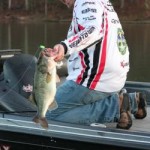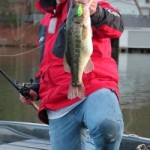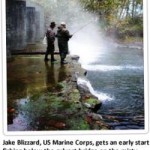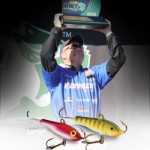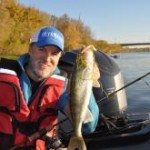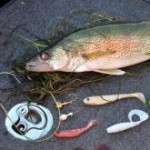One Time, One Place for Alabama Largemouth
By Millard Rooney
from The Fishing Wire
If you could be on the water in Alabama only one week out of the year and wanted the best largemouth fishing for numbers and quality, where would you go and what would you throw?
Captain Jimmy Mason puts the grip on a keeper from North Alabama’s TVA chain.It’s a tough question, given the ample opportunities for great largemouth bass fishing on the Tennessee River in north Alabama. The state has four impoundments — Guntersville, Wheeler, Wilson and Pickwick — along the 652-mile long river that snakes through Alabama, Tennessee and Kentucky. You can’t overlook famed Lake Eufaula, either, for outstanding largemouth bass fishing.
Guntersville, Pickwick and Eufaula generally are considered among the best for numbers and size. At certain times of the year on any of these three, you can catch a 10-pounder or rack up a memorable day with numbers that leave your thumbs raw and mind racing. In each lake, the buffet of forage, deep and shallow water, aquatic vegetation, structure changes, cover and water current from hydroelectric dams combine for endless opportunities.
More than two decades of fishing and guiding on the Tennessee River give Jimmy Mason a unique perspective. As a guide or tournament competitor he’s plied all of the Tennessee River impoundments during all four seasons. He’s also fished Alabama’s other notable lakes, including Eufaula and the Coosa River chain, which has good largemouth but is known more for its spotted bass.
Mason says spring is prime time for numbers, but if you want a trophy, head to Pickwick the first week of February and fish an umbrella rig like the Flash Mob.“It’s kind of hard to answer, honestly, because there are really good times for big fish and other times for catching a lot of fish,” Mason said. “As much as I’ve fished on all the lakes, though, I’d have to say Pickwick would be my top choice for the chance of catching a truly big bass, a 10-pounder, and also for catching a lot of bass.”
Pickwick Lake is located in the northwest corner of Alabama, a 53-mile long impoundment with more than 43,100 acres of surface area and 490 miles of shoreline. Thanks to the topography of the area, the river is replete with gravel bars, rocky bluffs, hard bottoms, shallow backwaters and numerous tributaries. It’s famous for its smallmouth bass, but in the last decade has seen a solid improvement in the quality of the largemouth bass population.
For landing a 10-pound largemouth, and possibly a 5- or 6-pound smallmouth, Mason says the first week of February is the prime time.
“If you were looking for a longer period I’d say from December through February, but for that one week out of the year when it can be really special, I’d say the first week of February,” he said. “One reason is the bait — the tremendous amount of shad in the lake. The other is the ability to throw the YUMbrella rig and target the big fish with it.
“The winter bite has been phenomenal the last few years for a legitimate chance at a 10-pounder. There probably have been 25 to 50 10-pounders caught that I know of, including several that are bigger than that, and likely a lot more that have been caught I don’t know about. When we get the winter rainfall that keeps the water color good and flowing through the dams to create a lot of good, consistent current, throwing the YUMbrella triggers that big cold-water bite and gives you the best chance to catch a 10-pounder.”
Prespawn Pickwick largemouth (and smallmouth) feast on shad, making the YUMbrella and other rigs that mimic a school of baitfish tremendously effective. Mason mixes up his offerings depending on water clarity.
“I’d fish several versions of rig at that time, including the Flash Mob Jr. and the full size version. For soft plastics I use a 5-inch YUM Money Minnow on the center arm and four 3 ½-inchers on the four surrounding arms. I like the Foxy Shad color for all of them,” Mason said.
It can be chilly in North Alabama in winter, especially at daybreak, but the fish keep right on biting all winter long.
Mason says that if the water is dirty he throws the full size Flash Mob, and is more likely to throw the Jr. size as the water clears. For really clear water, he removes the Money Minnows surrounding the center arm and replaces them with curly-tail grubs.
“I’ll throw these in current eddies or where the current hits the bank directly and causes an eddy, and will be looking for the eddy spots along the bank. It’s all related to current. If you catch one bass, you have a chance to catch several more big fish because they school in these eddies. You also have a chance to catch a 10-pound largemouth and 5- or 6-pound smallmouth in the same area. There are only a few lakes in the country where you can do that.”
For numbers of fish, Mason said the third week of May on Pickwick is the one to circle on the calendar.
“That’s when, generally, the big schools of post-spawn fish move out on the deeper structure — the first big structure off the spawning areas,” he said. “You can sit on a spot and hammer them. Sometimes the schools will look the size of a house on the sonar.
“My favorite bait to throw then is the Fat Free Shad in the Citrus Shad color. Chartreuse with a black back also is good, as is Foxy Shad. That’s also a good time to throw a 3/4-ounce Booyah football jig with a big craw or a 10-inch worm.”
